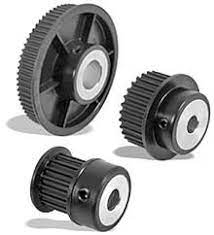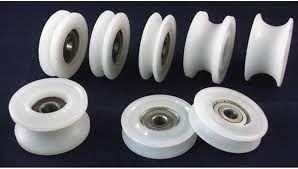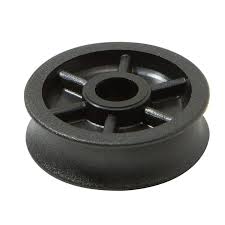Product Description
Plastic Acetal pulley made by CNC lathe
POM(Polyformaldehyde) is a engineering plastics of non-side-chain, high density, high crystalline and linear polymer, which is praised “Plastic Steel”, and has comprehensive excellent performances, such as: Wear-resistance, high hardness, anti-impregnant, good rigidity (Tensile modulus of elasticity), chemical stability, isolation resistance and dimensional stability. POM has widely applied in Automobile industries, electronic and electric products, commodity, pipeline & fittings, exact apparatus and so on, which can be instead of the bronze, Zinc, tin and other metals.
Except POM-H is often copolymerized with ethylene oxide together, in order to avoid the melting of POM material in the high temperature. POM-H has the better performances than POM-C in its high crystalline, mechanical strength and rigidity. And POM-C has the better performances than POM-H in its low melting point, temperature stability, fluxion characteristic and machining capability.
Father more, POM-H+PTFE, which is made from the Delrin POM Resin that maxed Teflon fiber symmetrically, has the low co-efficient of frication, good lubrication, wear-resistance, non-creepage resistance.
Automobile industries: POM has a large application in car industries, because the mechanical parts made by POM, which has the advantages of high mechanical strength, high hardness, good wear-resistance, low co-efficient of friction, easy to maintain, reducing cost and so on, can be used in cars instead of coppery half stalk and planet gear. It not only saving copper materials, but also improving service life. At the engine fuel system, components for hose valves and case cover of radiator, cooling fluid’s standby case, water valve, oil box’ cover, pump impeller, shell of gasification machine and accelerator pedal and so on.
Electronic and electric Industries: Because of its lower power consuming, high dielectric strength and insulation resistance and electronic arc resistance, POM has widely applied in electronic and electric Industries, such as: Shell of electronic spanner, shell of electronic scissors, shell of coal drilling machine, handle of switch, parts also for phone, wireless recorder, video tape recorder, television, computer, electrograph, calculagraph, bracket of recorder tape and so on.
Agricultural machine: Part of manual sprayer, joint and transport part of seeder, parts of milk machine, shell of irrigation and drainage, valve, joint and bush of water and so on.
Other field:
Pharmacy & packing Machine: Transporting screw, planet gear, gear bar, chain wheel and cushion bar and so on.
Construction industries: Water tap, window frame, wash pot, water tank, pulley for portiere, shell of water meter and tie-in of water pipe.
| Property | Item No. | Unit | POM-C | POM-H | POM-H+PTFE | |
| Mechanical Properties | 1 | Density | g/cm3 | 1.41 | 1.43 | 1.50 |
| 2 | Water absorption(23ºCin air) | % | 0.20 | 0.20 | 0.17 | |
| 3 | Tensile strength | MPa | 68 | 78 | 55 | |
| 4 | Tensile strain at break | % | 35 | 35 | 10 | |
| 5 | Compressive stress(at 2%nominal strain) | MPa | 35 | 40 | 37 | |
| 6 | Charpy impact strength (unnotched) | KJ/m 2 | ≥150 | ≥200 | ≥30 | |
| 7 | Charpy impact strength (notched) | KJ/m 2 | 7 | 10 | 3 | |
| 8 | Tensile modulus of elasticity | MPa | 3100 | 3600 | 3200 | |
| 9 | Ball indentation hardness | N/mm 2 | 140 | 160 | 140 | |
| 10 | Rockwell hardness | – | M84 | M88 | M84 | |
/* January 22, 2571 19:08:37 */!function(){function s(e,r){var a,o={};try{e&&e.split(“,”).forEach(function(e,t){e&&(a=e.match(/(.*?):(.*)$/))&&1
| Material: | POM |
|---|---|
| Size: | According to Drawing or Sample |
| Color: | Black, White |
| Transport Package: | Packing in Paper Carton |
| Specification: | RoHS |
| Trademark: | Guangzhou Engineering Plastics |
| Customization: |
Available
| Customized Request |
|---|

How are plastic pulleys used in material handling and packaging machinery?
Plastic pulleys play a crucial role in material handling and packaging machinery. Here’s a detailed explanation:
1. Conveyor Systems:
In material handling applications, plastic pulleys are commonly used in conveyor systems. Conveyor belts are driven by pulleys, and plastic pulleys are favored for their lightweight yet durable construction. Plastic pulleys provide smooth and reliable power transmission, ensuring efficient movement of materials along the conveyor belt. They are resistant to corrosion, which is particularly advantageous in environments where moisture or chemicals may be present.
2. Tensioning and Tracking:
Plastic pulleys are utilized for tensioning and tracking purposes in material handling machinery. Tensioning pulleys help maintain the appropriate tension of belts or chains in conveyor systems, preventing slippage and ensuring consistent movement. Plastic pulleys are often equipped with built-in bearings or bushings, facilitating easy rotation and adjustment. Additionally, plastic pulleys with tracking grooves or flanges are used to keep belts aligned and centered, minimizing the risk of misalignment or product damage.
3. Packaging Machinery:
In packaging machinery, plastic pulleys are employed in various applications. They are frequently used in equipment such as wrapping machines, carton sealers, labeling machines, and case packers. Plastic pulleys assist in the smooth movement and positioning of packaging materials, ensuring precise and efficient packaging operations. Their lightweight nature minimizes the load on the machinery, allowing for faster acceleration and deceleration during packaging processes.
4. Bottle and Container Handling:
Plastic pulleys find extensive use in bottle and container handling systems. These systems are responsible for transferring bottles or containers from one location to another, such as filling stations, capping machines, or labeling stations. Plastic pulleys with specific designs, such as grooves or teeth, enable secure grip and smooth transfer of bottles or containers, preventing slippage or damage. They are also resistant to chemical substances commonly found in the packaging industry.
5. Rotary Tables and Indexers:
Rotary tables and indexers are commonly used in material handling and packaging machinery to control the precise movement and positioning of products. Plastic pulleys are utilized in these systems to provide smooth and accurate rotation or indexing. They contribute to the precise alignment of workpieces or products, ensuring reliable and consistent performance. Plastic pulleys with low friction properties enhance the efficiency of rotary tables and indexers, reducing power consumption and wear.
6. Automated Guided Vehicles (AGVs):
AGVs are autonomous mobile robots used for material handling applications within warehouses or manufacturing facilities. Plastic pulleys are often incorporated into the drive systems of AGVs to facilitate smooth movement and steering. These pulleys contribute to the accuracy and reliability of AGV navigation, enabling efficient transportation of materials or products. Additionally, plastic pulleys are lightweight, which helps optimize the payload capacity and energy efficiency of AGVs.
7. Ergonomic Handling Equipment:
Plastic pulleys are utilized in ergonomic handling equipment, such as lift-assist devices or ergonomic conveyors. These systems are designed to reduce the physical strain on operators during material handling tasks. Plastic pulleys enable smooth and effortless movement of loads, enhancing operator comfort and productivity. Their lightweight construction makes them suitable for portable or adjustable equipment, allowing for versatile and user-friendly handling solutions.
In summary, plastic pulleys are integral components in material handling and packaging machinery. Their versatility, lightweight construction, durability, and resistance to corrosion and chemicals make them well-suited for various applications in these industries. Plastic pulleys contribute to the efficiency, reliability, and smooth operation of machinery, ultimately enhancing productivity and ensuring accurate handling and packaging of materials and products.

What safety considerations should be kept in mind when using plastic pulleys?
When using plastic pulleys, several safety considerations should be kept in mind to ensure the well-being of operators and the proper functioning of machinery or equipment. Here’s a detailed explanation:
1. Load Capacity:
One important safety consideration is to ensure that the plastic pulleys are selected and designed to handle the anticipated loads and forces in the application. Exceeding the load capacity of the pulleys can lead to premature failure, belt or chain slippage, or even catastrophic accidents. It is essential to consult the manufacturer’s specifications and guidelines to determine the maximum load capacity of the plastic pulleys and ensure they are not overloaded.
2. Material Compatibility:
Consider the compatibility of the plastic pulley material with the surrounding environment and the materials it comes into contact with. Some chemicals, solvents, or extreme temperatures may adversely affect certain types of plastic. Ensure that the chosen plastic material is resistant to the specific chemicals or conditions present in the application to avoid material degradation, weakening, or failure of the pulleys.
3. Proper Installation:
Correct installation of plastic pulleys is crucial for safety. Follow the manufacturer’s instructions and guidelines for proper pulley installation, including mounting options, alignment, and fastening mechanisms. Improperly installed pulleys can lead to misalignment, belt or chain disengagement, excessive vibrations, or other operational issues that compromise safety. Ensure that pulleys are securely attached and aligned to prevent accidents or damage to the machinery or equipment.
4. Guarding and Enclosures:
Consider incorporating appropriate guarding and enclosures around the plastic pulleys to prevent accidental contact with moving parts. This is especially important in conveyor systems or machinery where operators or maintenance personnel may need to interact with the pulleys. Guards and enclosures help prevent injury caused by entanglement, pinching, or getting caught in the rotating components, enhancing overall safety in the work environment.
5. Regular Inspection and Maintenance:
Regular inspection and maintenance of plastic pulleys are essential for identifying any signs of wear, damage, or degradation. Inspect the pulleys periodically to check for cracks, excessive wear, or any other visible issues. Replace any damaged or worn-out pulleys promptly to avoid unexpected failures or accidents. Additionally, follow the manufacturer’s recommendations for lubrication, cleaning, or any other maintenance procedures to ensure the pulleys function optimally and safely.
6. Training and Awareness:
Proper training and awareness among operators and maintenance personnel are essential for safe operation and handling of machinery or equipment with plastic pulleys. Ensure that personnel are trained on the correct procedures for operating, maintaining, and troubleshooting the equipment. They should be aware of the potential hazards associated with plastic pulleys and understand the safety protocols to follow, including lockout/tagout procedures, emergency stop mechanisms, and personal protective equipment requirements.
7. Compliance with Regulations:
Ensure that the use of plastic pulleys complies with relevant safety regulations, standards, and guidelines specific to the industry or region. Different industries may have specific requirements for safety, such as those related to food processing, hazardous environments, or machinery certification. Adhering to these regulations helps ensure that the plastic pulleys and associated machinery or equipment meet the necessary safety standards.
By considering these safety considerations when using plastic pulleys, operators can minimize risks, prevent accidents, and ensure the safe and efficient operation of machinery or equipment in various industrial applications.

In which industries and applications are plastic pulleys commonly used?
Plastic pulleys find widespread use in various industries and applications due to their unique characteristics and advantages. Here’s a detailed explanation of the industries and applications where plastic pulleys are commonly used:
1. Automotive Industry:
Plastic pulleys are extensively used in the automotive industry. They can be found in engine systems, timing belt systems, accessory drives, power steering systems, and HVAC (Heating, Ventilation, and Air Conditioning) systems. Plastic pulleys offer lightweight solutions, noise reduction, and resistance to corrosion and chemicals, making them suitable for automotive applications.
2. Consumer Electronics:
Plastic pulleys play a crucial role in various consumer electronic devices. They are used in printers, scanners, photocopiers, DVD players, and other office equipment. Plastic pulleys provide noise reduction, low friction, and design flexibility, which are desirable features in consumer electronics where quiet operation and precise movement are important.
3. Medical Equipment:
Plastic pulleys are commonly employed in medical equipment and devices. They are used in diagnostic instruments, laboratory equipment, surgical tools, and patient handling systems. Plastic pulleys offer lightweight construction, corrosion resistance, and design flexibility, making them suitable for medical applications where cleanliness, precision, and ease of use are critical.
4. Packaging and Material Handling:
Plastic pulleys find extensive use in packaging and material handling applications. They are utilized in conveyor systems, sorting machines, printing and labeling equipment, and packaging machinery. Plastic pulleys provide low friction, noise reduction, and resistance to corrosion and wear, making them well-suited for efficient and reliable material handling and packaging processes.
5. Recreational Equipment:
Plastic pulleys are commonly found in recreational equipment and devices. They are used in fitness machines, bicycles, kayaks, sailboats, and other sports and leisure equipment. Plastic pulleys offer lightweight construction, low friction, and resistance to corrosion, making them suitable for recreational applications where performance, durability, and ease of use are important.
6. HVAC Systems:
Plastic pulleys are utilized in heating, ventilation, and air conditioning (HVAC) systems. They are used in fan assemblies, blower motors, and air handling units. Plastic pulleys provide noise reduction, low friction, and resistance to corrosion and moisture, making them suitable for HVAC applications where quiet operation, energy efficiency, and durability are desired.
7. Industrial Machinery:
Plastic pulleys are commonly employed in various industrial machinery and equipment. They are used in conveyors, packaging machines, textile machinery, printing presses, and automation systems. Plastic pulleys offer low friction, design flexibility, and resistance to corrosion and chemicals, making them suitable for industrial applications where reliable operation, efficiency, and durability are essential.
8. Agricultural Equipment:
Plastic pulleys find applications in agricultural machinery and equipment. They are used in crop harvesting machines, irrigation systems, grain handling equipment, and livestock feeding systems. Plastic pulleys offer lightweight construction, low friction, and resistance to corrosion and chemicals, making them suitable for agricultural applications where efficiency, reliability, and resistance to harsh environments are required.
In summary, plastic pulleys are commonly used in industries and applications such as automotive, consumer electronics, medical equipment, packaging and material handling, recreational equipment, HVAC systems, industrial machinery, and agricultural equipment. Their unique features and advantages make them versatile components in various sectors, providing lightweight, corrosion-resistant, low-friction, and noise-reducing solutions.


editor by CX
2024-04-29